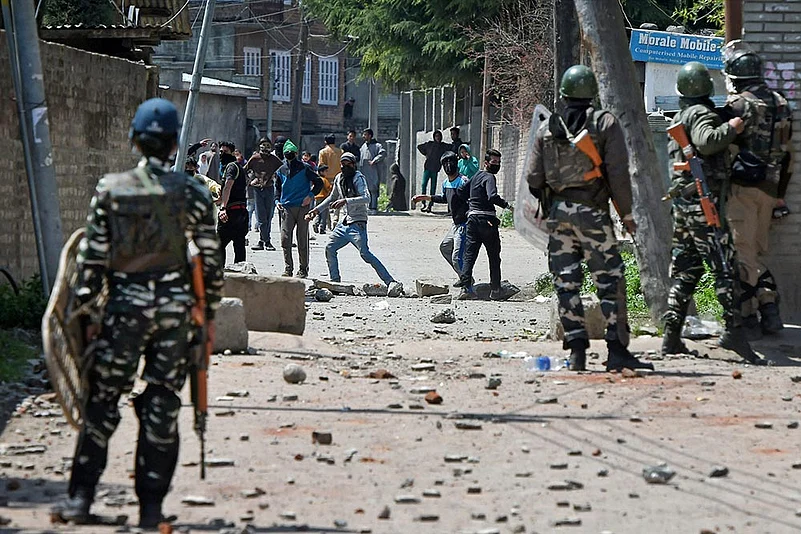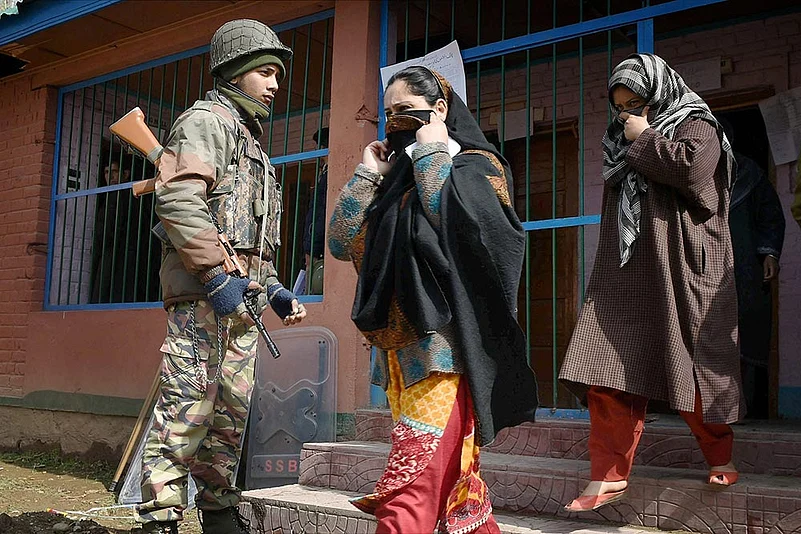“The youngsters here are angrier than they were in the 1990s,” Andrew Whitehead, who had been to Kashmir several times during that tumultuous decade as a BBC correspondent and went on to write A Mission in Kashmir, told locals who had come for his talk at a café on Residency Road near Srinagar’s Lal Chowk a few days ago. Recalling his conversation with an elderly woman with no separatist leanings, he said she remembered the 1990s as a time when the people were “angry and scared”, unlike now when most of them are “angry and fearless”.
Anger and fearlessness, indeed, were abundantly on display in the streets—and especially around the polling booths as Srinagar went to polls on April 9. With almost all separatist leaders either under house arrest or in jails, internet connections snapped, government forces in huge numbers manning the roads, streets, lanes and bylanes, the constituency that had in 2014 elected the People’s Democratic Party’s (PDP) Tariq Hameed Karra—the MP who resigned protesting against the crackdown on protests following the killing of Hizbul Mujahideen’s 21-year-old commander Burhan Wani last July—saw just 7.14 per cent (90,050) of the electorate (12,61,395) cast their votes for deciding who would represent them in the Lok Sabha—former CM Farooq Abdullah of the National Conference (NC), who had lost to Karra by a record 40,000 votes in 2014, his first poll defeat in a four-decade-long political career, or the ruling PDP’s Nazir Ahmad Khan.
The voter turnout this time is the lowest since 1967, when the first Lok Sabha election was held in Jammu and Kashmir. Even after the 2008 unrest over the Amarnath land transfer row and economic blockade of the Valley, the turnout in the 2009 Lok Sabha polls was much higher: 26.55. “People have rejected this sham election as they are no longer interested in status-quoist politics,” Mirwaiz Umer Farooq, leader of the moderate faction of the Hurriyat Conference, an amalgam of pro-independence civil society groups, tells Outlook. Mirwaiz believes this is a resounding defeat for those who had been arguing for years that participation of Kashmiris in elections can be read as a sign of their accepting the idea of Kashmir being an “integral part of India”—if a 26 per cent turnout in Srinagar in the 2014 Lok Sabha elections signalled India’s improving stock in Kashmir since the 2010 unrest, what would the latest figure signify?
The 7.14 turnout this time also lends more credence than ever before to the argument that whenever the percentage has been comparatively higher—for example, 41 per cent in 1996, following five years of President’s Rule—at least some of it could be attributed to government forces coercing the people to vote.

“This boycott had little to do with the separatists,” says a young man in Srinagar’s Old City, who did not wish to be named. “In the 2008 and 2014 assembly polls, the people heeded the separatists’ boycott calls only partially, but this time they have boycotted the polls on their own and it is near-total.” No wonder, J&K’s chief electoral officer Shantmanu described April 9 as “not a good day for us”. The day also saw over 250 incidents of violence and the killing of eight persons, including a 15-year-old boy, in the firing by government forces.
Worryingly for the government, seven of the dead were from Budgam, often touted as a “bastion of pro-India politics”. When Outlook visited a polling booth near Budgam’s main chowk, a stone’s throw away from the house of the local NC legislator, there was no queue of voters. Instead, around a dozen young men were hanging out outside the booth, keeping a keen eye on every movement. “The condition is bad. I don’t know what’s in store this year,” says a CRPF jawan from Siliguri, West Bengal, and moves a little farther away from the youths.
“No one will vote here,” says a middle-aged man standing outside his closed grocery shop near the polling booth at Bogur village. “What have these politicians done for us except killing our children?” When Muneer, 26, joins in, saying, “Nobody trusts politicians anymore”, his mother comes rushing behind him and pleads with him to go inside. “Don’t be on the road. They can fire anytime,” she says, pointing at the paramilitary forces. “And what can they do besides killing us?” Muneer asks his mother in turn. All this while, stones pelted intermittently from a nearby alley were landing around the paramilitary personnel.
At Kremshar, another place that had seen higher turnouts in previous elections, the roads are littered with stones, broken bricks and shards of glass from broken windscreens. Despite no internet, news of deaths and injuries in police firing kept poured in through the day. In remote Hardu Dulwan at Charar-e-Sharief, bordering volatile Pulwama, eyewitnesses say the BSF opened fire on protesters, killing 15-year-old Faizan Dar and another youth. At a few other places, however, the government forces left when the locals demanded they must. Elsewhere, young men shouting Azadi slogans were seen running after CRPF personnel, chasing them away.
On April 10, NC spokesperson Junaid Azim Mattu was the only one in his office—one of the few places with internet access even when the government snaps internet services across the Valley. He was hoping the Election Commission of India (ECI) would postpone the Anantnag bypolls, following a request by PDP candidate Mufti Tassaduq, brother of CM Mehbooba Mufti. Some polling booths in the constituency, mostly in schools, had already been set on fire. Eventually, the Anantnag bypoll was deferred from May 12 to May 25.
“We have been saying the situation is not conducive for elections. Tassaduq’s appeal is an indictment of the state government,” Mattu tells Outlook, adding that the low turnout was the people’s response to the failure of the pro-India parties to address the political conflict over the fate of Kashmir. He blames the Centre for the political radicalisation of Kashmiri youth, by leaving them no non-violent recourse to pursue their political aspirations.
Unlike the NC, PDP leaders give the impression of being caught unawares by the extent of the boycott and insist on looking at it through an NC/PDP prism. Interestingly, Naeem Akhtar, chief spokesman of the PDP-BJP coalition, blames the NC’s lack of credibility for the dismal turnout. “In 2008 and 2014, people came out to vote as we had credibility as the opposition. The NC, on the other hand, couldn’t even hold a workers’ meeting,” he says.
However, as intelligence sleuths have been letting on, this spell of anger goes beyond the NC, the PDP and even the separatists. According to senior police officials, the turnout would not have been better had the separatists not given a boycott call. The officials blame it on the ‘mainstream’ parties not delivering on their promises—such as NC’s “autonomy” or PDP’s “self-rule”—and being seen more and more as “anti-people”, especially after the handling of protests in 2008, 2010 and 2016. And while the PDP has been pleading for dialogue with separatists and Pakistan—as it fears more face-offs with the angry and fearless locals, who rush to encounter sites with only stones in their hands to save militants, could lead to another spell of violence spiralling out of control—its ally at the Centre is yet to pay heed.
By Naseer Ganai in Srinagar and Budgam
















